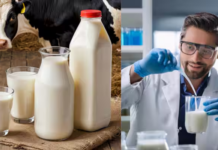New Delhi, October 10, 2022: The researchers asked 70 experts from around the world to assess the welfare risks of the most common dairy and beef production systems in their own country.
“We hope our findings may encourage a more sustainable and responsible food consumption,” says Roi Mandel Briefer, a postdoc at the University of Copenhagen.
“The welfare is worse with cattle in the most common dairy production systems in opposition to cattle in the most common beef production systems. These findings contradict a very long and widely held belief in our society,” Briefer says.
It is the first time that these predictions are being tested, validated, and published. Experts’ ratings addressed all main aspects of welfare related to the animals’ basic health and functioning, feelings, and their ability to engage in natural behaviors.
“The higher welfare risk in the dairy sector is not limited to dairy cows—defined from first calving onwards—but also, to their calves. Experts rated the welfare risk of calves originating from dairy herds to be higher than that of calves originating from beef herds, regardless of the production goal, be it for red-meat, veal, or to replace the dam,” says Briefer.
The researchers expect that the welfare assessment is the same in organic production, because dairy in organic production are also used for more than milk, the key reason for the worse welfare.
Raising dairy animals in better conditions may certainly improve their welfare in some contexts, Briefer says. “However, if such measures are similarly applied to bovines in the beef herds, then they may retain their perceived higher welfare status.”
Reflecting on why the results point to reduced welfare for animals in dairy systems, Briefer explains that dairy production involves a higher degree of intervention, since dairy cattle are used to provide milk for human consumption, whereas the beef cows produce milk for their own calves according to the reports published in futurity.org.
The milk from dairy cows, produced in considerably higher volumes than in beef cows, is collected one to three times per day, often for 305 days or more per lactation. That has implications for how these animals and their calves are raised and managed. Early separation of calves from their dams, a common practice in dairy herds, is one example.
The study also notes that long-term genetic selection for high milk yield in dairy cows is recognized as a major factor causing poor welfare. In particular, it results in health problems such as lameness, mastitis, reproductive disorders, and metabolic disorders.
“Refining or simply eliminating, when possible, husbandry practices that have long been recognized as compromising the welfare of both cows and their calves, such as early separation of the calves from their dams, may help to minimize the welfare gap between the beef and the dairy sector,” Briefer says.
“A complementary approach that applies to both sectors, dairy or beef, would be to elevate overall welfare e.g. by better training of animal handlers. Unfortunately, in many regions of the world, training of animal handlers is not mandatory. In other countries periodic training updates could be required.”
The researchers emphasize that the results don’t necessarily mean that animals born in dairy herds are, at any given point of time and in every type of system, worse off than animals born in beef herds.
“However, when it comes to making food or policy decisions based on general expert welfare assessment, our findings may suggest a revision of the current image of the dairy sector compared to the beef sector,” says Briefer.
“Raising awareness about the fact that dairy production also produces meat, and the toll of milk production on the welfare state of animals in the dairy industry, would hopefully encourage a more sustainable and responsible food consumption. Labeling the origin of the meat (beef/dairy herd) on food packaging, could be a first step in this process.”
The study is published in the journal Animal. Additional coauthors are from Wageningen Livestock Research, Royal Veterinary College in London, the University of Bristol, and Humboldt-Universität in Berlin.

































